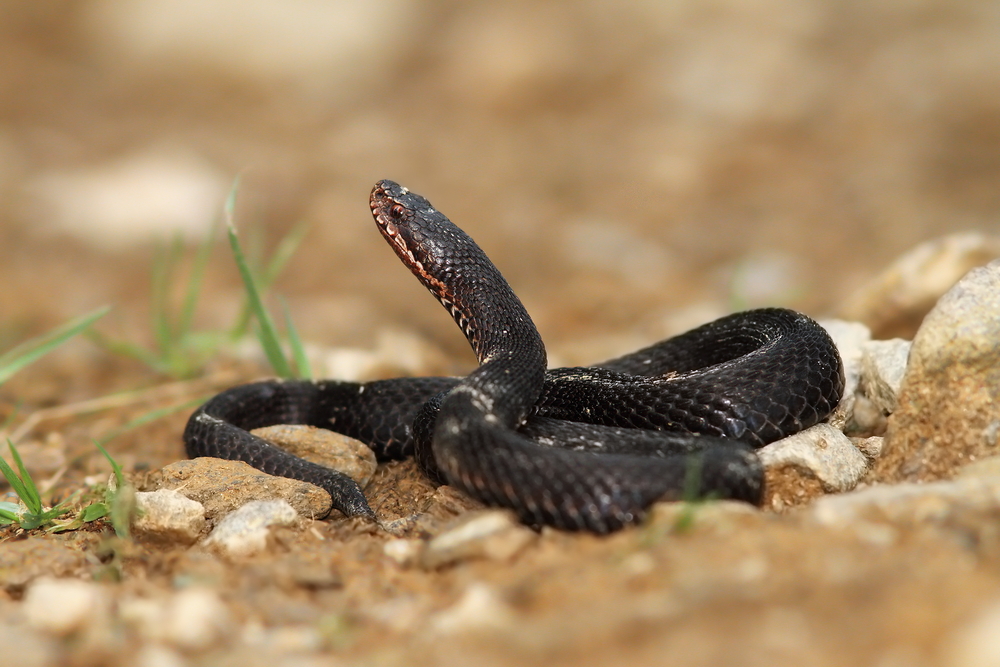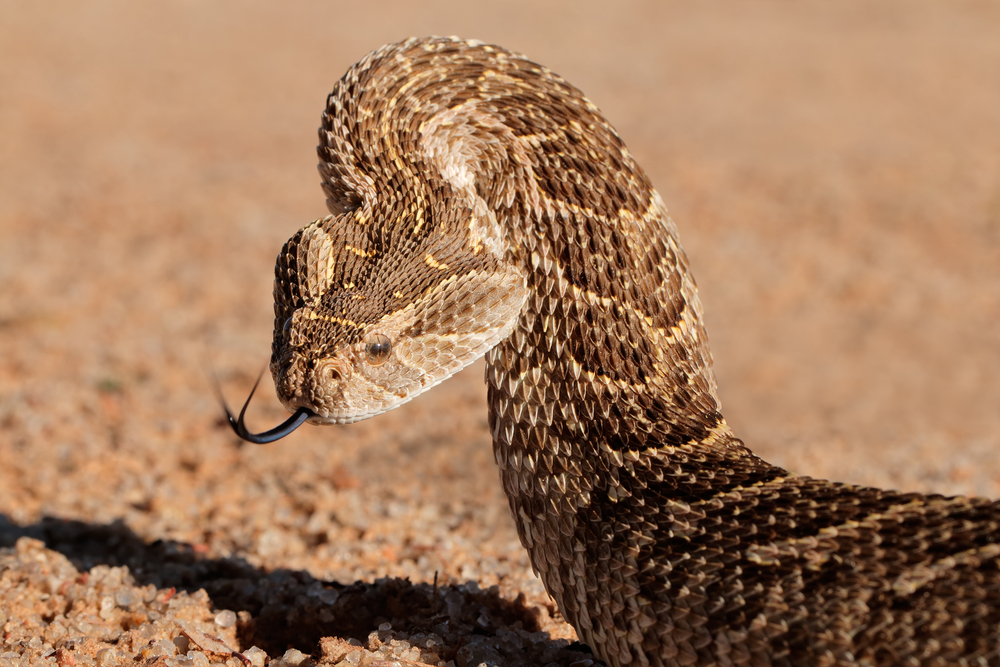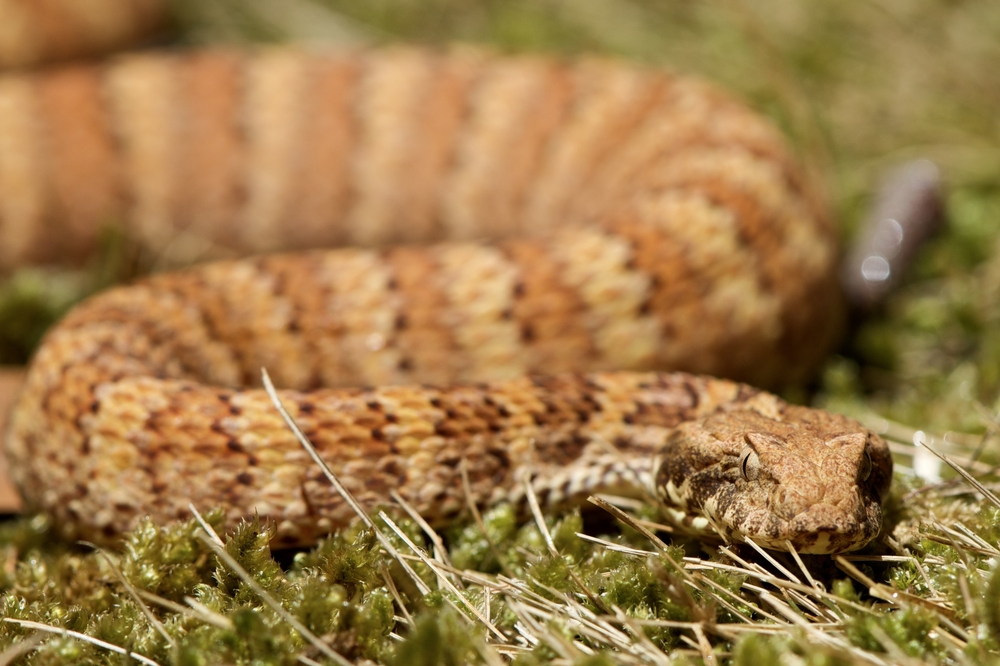Facts About Adders

Adder is a word derived from an Old English term meaning serpent, and it can refer to several types of snakes, including some species that are only distantly related. Some adders are in the viper family, but they are in different genera, such as the common adder or black adder of Europe (Vipera berus) and the puff adder of Africa (Bitis arietans). The death adders of Australia and Oceania (genus Acanthophis) are in the Elapid family, along with cobras, coral snakes, mambas and many others. Most adders are venomous but not all are considered especially dangerous to humans.
The term adder was adopted for these different snakes because they physicially resemble each other, even though they are not all related, according to Alan Savitzky, a professor of biological sciences at Utah State University specializing in the biology of snakes. For example, snakes in the genus Acanthophis, which are actually related to cobras, "are called death adders because of their physical resemblance to vipers."
Eastern hognose snakes (Heterodon platirhinos), found in the eastern United States, are sometimes called puff adders because when confronted, they puff up the skin around their heads like a cobra, hiss and lunge, according to the Savannah River Ecology Laboratory. However, these snakes eventually play dead and almost never bite. They are nonvenomous and should not be confused with the venomous African variety (genus Bitis).
Black adder or European adder
While the common names of several species contain the word "adder," the only species whose common name is simply adder is Vipera berus, according to the University of Michigan's Animal Diversity Web (ADW). Also called the common adder, common European adder, black adder or the common European viper, it is found throughout most of western Europe and into east Asia, and is the only venomous snake native to Britain, according to the Forestry Commission of England.
Physical characteristics
"Black or European adders are relatively small," Savitzky said. Adults average about 24 inches (7.3 meters) long and are relatively thick-bodied.
Black or European adders are usually gray or reddish brown, though they can also be black, white, cream or pale yellow. Adders have a V shape on their heads and scales that partially cover their eyes, giving them a lidded appearance. Most adders have distinctive black or dark brown zig-zag markings on their backs, said Savitzky. Some, however, are pure black (hence the term, "black adder"). Females are generally redder and browner than males, which tend to have more gray, black and white coloring. Females are also larger.
Get the world’s most fascinating discoveries delivered straight to your inbox.
Like other vipers, black or European adders have hinged fangs through which venom is injected into prey. Hinged fangs fold up and lie against the roof of the snake's mouth. This allows their fangs to grow relatively long, according to Andrew Solway, author of the book "Deadly Snakes" (Heinemann-Raintree, 2005).
Range
According to the Durrell Wildlife Conservation Trust, black or European adders have the largest range of any terrestrial snake in the world. They are the only snakes that live above the Arctic Circle. They extend from the upper reaches of Scandinavia south to northern Greece and east to Northern China and Korea. They also live at the highest elevation of any snake — up to 8,500 feet (2,591 meters) above sea level.
Habitat
Black or European adders are often found on the edge of the woods, in open countryside, according to the Forestry Commission of England. They like to have open meadows or dunes for basking in the sun, but also leaves, scrub, or rocks to hide beneath when threatened. They are not commonly found in urban areas.
Habits
Black or European adders are solitary, shy snakes. Though they have relatively good eyesight, they rely primarily on their sense of smell when mating, according to Solway.
Adders are most commonly seen during sunset, when they go out to hunt. They are primarily terrestrial. Black or European adders in colder climates hibernate for five to seven months during the winter, according to the Durrell Wildlife Conservation Trust. They stay in abandoned mammal or tortoise burrows. Many adders will hibernate together. Young adders tend to hibernate in the place they were born.
Hunting and feeding habits
Adders feed mostly on small mammals, said Savitzky. They also eat lizards, nesting birds and frogs. Adders employ both ambush and active hunting techniques. Once they have identified their prey, they strike it and inject venom. They then immediately release the prey so that it cannot bite back. The bitten prey wanders off, dies and the adder uses its sense of smell to find it.
Reproduction and lifespan
During warm spring days, male adders actively search for females by picking up pheromones in the air. They sometimes wrestle other males for the same female, slithering across the ground quickly. The males raise their bodies and intertwine with each other, a movement the Durrell Wildlife Conservation Trust calls "dance of the adders." Originally thought to be a mating display, it is actually an attempt to drive a competing male out of range.
Black or European adders are ovoviviparous, said Savitzky. That means the eggs are fertilized and incubate inside the mother and she gives birth to live young. The gestation period is three to four months. Adders typically give birth to about 12 babies, which are independent soon after birth. The mother may stay with them for a few hours.
Adder babies are about 7 inches (17.8 centimeters) long. The Forestry Commission of England describes them as perfect miniatures of adult snakes. They are sometimes born during hibernation, so they are born with excess fat stores to help them through their first winter.
Adders reach sexual maturity between 3 and 4 years of age. They can live for up to 15 years in the wild, according to the ADW.
Bite
According to the Forestry Commission of England, no one has died of an adder bite in Britain in more than 20 years. Though they are venomous, they are not aggressive, and when threatened only use their venom as a last resort. Humans are most likely to be bitten if they step on or try to pick up an adder.
Adders "have relatively moderate venom, not highly lethal," said Savitzky. They are, however, "unpleasant and could cause potentially serious medical issues. Though they are usually not lethal, that doesn't mean that they don't deserve treatment." He noted that they could still be fatal, mostly for children or the elderly.
Endangerment status
The International Union for Conservation of Nature's Red List of Threatened Species, lists black or European adders as a species of least concern. They are protected in the United Kingdom, according to the Scottish Wildlife Trust.
Puff adder
Sometimes called African adders, puff adders (Bitis arietans) are members of the viper family. "Generally, more venomous vipers are in tropical areas, such as South America and Africa," Savitzky said. That is certainly true for the puff adder, which is more venomous and dangerous than its European relatives. According to A Field Guide to the Reptiles of East Africa, puff adders are responsible for the most snakebite fatalities in Africa.
Physical characteristics
Puff adders average about 3 feet (1 meter) in length and have stout bodies. They have light brown, gray, and black markings with a distinctive chevron pattern, according to the Sabi Sabi Game Reserve in South Africa. Their coloring makes for effective camouflage. Like most vipers, their heads have a triangular shape and are distinct from their necks. Males are larger than females. Like other vipers, puff adders have hinged fangs through which venom is injected into prey.
Range
Puff adders are widespread throughout Africa, Savitzky said. They live in most of sub-Saharan Africa except the rainforests in west and central Africa. Puff adders are found across the Red Sea in the southwest corner of Saudi Arabia, Yemen, and in in the southwest corner of Oman.
Habitat
Puff adders primarily live in rocky savannahs, though they are found almost everywhere in Africa except deserts and rainforests. A primary reason they bite so many people is that they are highly adaptable snakes and often live in developed places, according to the Sabi Sabi Game Reserve.
Behavioral habits
Puff adders are out both during the day and at night, though they are more active at night, according to Perry's Bridge Reptile Park in South Africa. Because of their stocky bodies, they are relatively slow-moving snakes. They rely on their camouflage for protection rather than their ability to move quickly. Puff adders move in a straight line, like a caterpillar, rather than in the side-to-side slithering motion of most snakes.
Puff adders are known for their aggressive temperament, though Savitzky says that might be overstated. Part of that reputation may come from the relative frequency of humans stepping on puff adders. Because they are slow and heavily camouflaged, it is possible for people to unintentionally get close to the snakes and step on them.
When threatened, puff adders inflate their upper bodies and hiss. This habit as given rise to their common name.
Despite their slow traveling speed, puff adders are known for their quick strike. According to Perry's Bridge Reptile Park, they can strike within 0.25 of a second of being threatened.
Puff adders are primiarily terrestrial, though they sometimes climb trees and are fond of swimming.
Hunting and feeding habits
Puff adders eat mostly small mammals, said Savitzky. They also eat birds and lizards. They do not actively hunt but wait and ambush their prey.
Reproduction
Like black adders, puff adders are ovoviviparous, said Savitzky; the young are born live. Puff adders mate in the spring and give birth to an average of 20 to 50 babies. According to Perry's Bridge Reptile Park, the gestation period lasts between seven and nine months. Babies are 5 to 7 inches (12.7 to 17.8 centimeters) long at birth and are born venomous.
Bite
Puff adders have cytotoxic venom, which means it destroys tissues in a process called necrosis, according to Sabi Sabi Game Preserve. Antivenom is available, however, and most fatalities occur not from the severity of the venom but from poor medical care.
Endangerment status
Puff adders have not been evaluated by the IUCN Red List or the Convention of International Trade in Endangered Species (CITES).
Death adders
Unlike other adders, death adders are not vipers. They are related to cobras, though they are not cobras, either. They are members of theAcanthophis genus in the Elapid family. There are seven subspecies, according Integrated Taxonomic Information System (ITIS). These are the common death adder, the Barkley Tableland death adder, the smooth-scaled death adder, northern death adder, desert death adder, rough-scaled death adder and the Pilbara death adder.
"They are called death adders because of their physical resemblance to vipers," said Savitzky. "Vipers are heavy-bodied and squat with triangular heads. Death adders look like that. And for good reason — like vipers they consume relatively large prey for their head and body size." Their similar appearance is due to convergent evolution, he said.
Physical characteristics
Death adders are short and stout, averaging between 15 and 35 inches (38 to 89 cm) in length, depending on the subspecies. They are usually gray, brown, black, reddish or yellow in color. Most have large bands around their bodies, and their coloring provides effective camouflage. They have a small, wormlike growth on the ends of their tails that they use to lure prey, according to the Queensland Department of Environment and Heritage Protection. Death adders have large fangs, though they are much smaller than a viper's.
Range
Death adders are found in Australia, New Guinea, and a few small surrounding islands, said Savitzky. They do not live in Tasmania.
Habitat
Death adders live throughout most of Australia, in heaths, around the edges of rain forests, grasslands and eucalyptus forests, according to the Queensland Murray Darling Committee, an Australian natural resources management organization. Desert death adders live in parts of the arid outback.
Behavioral habits
Death adders are effectively camouflaged, and their defense strategy relies on this. When they feel the vibrations of approaching large animals, including humans, they burrow deep into leaf litter or other debris, rather than moving out of the way as most snakes do. This caused early European settlers of Australia to think that they couldn't hear (no snakes truly hear), giving rise to the name "deaf adder," which later morphed into death adder, according to the CSL Antivenom Handbook.
Death adders will strike quickly if stepped on or otherwise threatened. They are shy, secretive snakes that spend most of their time partially hiding under rocks or other ground cover to ambush their prey, according to the Australian Museum.
They are both diurnal and nocturnal depending on the local climate, according to the Queensland Department of Environment and Heritage Protection.
Diet and hunting habits
Death adders eat mostly small mammals, said Savitzky. Younger death adders eat lizards, birds and frogs. They are ambush predators with the fastest strike of any snake in Australia, according to the Queensland Department of Environment and Heritage Protection.
Reproduction
Death adder females reproduce every two years, according to the Queensland Department of Environment and Heritage Protection. They mate in the spring and between 10 and 20 babies are born in autumn. Like other adders, death adders are ovoviviparous.
Bite
"Death adder venom is very potent, but it's a very different kind of venom," said Savitzky. "It has a larger proportion of toxins that affect nerve transmission and breathing centers, whereas vipers in general tend to have enzymatic venom that affects general tissues."
According to the CSL Antivenom Handbook, before antivenom was introduced in the early 20th century, death adder bites had a 50 percent mortality rate. Today, the mortality rate is quite low. Most bites in urban areas are not envenomed, meaning the snake did not inject any venom with its bite.
Endangerment status
Death adders are listed as stable on the IUCN's Red List. According to the Queensland Department of Environment and Heritage Protection, common death adders are vulnerable. Other species are declining in number because of human development in their habitats.
Additional resources
Jessie Szalay is a contributing writer to FSR Magazine. Prior to writing for Live Science, she was an editor at Living Social. She holds an MFA in nonfiction writing from George Mason University and a bachelor's degree in sociology from Kenyon College.




